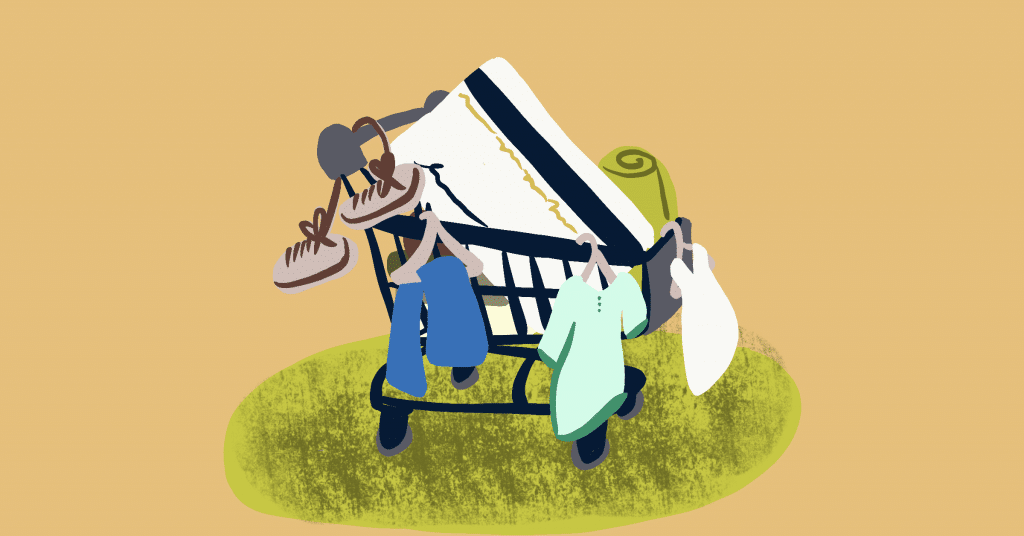Pretend you’re a cobbler — the shoemaker, not the warm fruit dessert. You have specialized tools and terminology that are unique to your trade. Fun fact: the little plastic or metal sheath on the end of a shoelace is called an aglet. You’re welcome.
Every industry has its own jargon; ecommerce is no different. It’s important to understand these terms when assessing the health of your business. So, to ensure that your customer acquisition plans and marketing strategies deliver the best results, you’ve got to know the lingo of the online marketplace.
With that in mind, we’ve created this ecommerce glossary that breaks down the complex terminology used by online vendors, sellers, suppliers, and service providers. Read on to learn more and keep this ecommerce glossary bookmarked for when future questions arise.
301 Redirect
301 Redirects permanently redirect traffic from one URL to another, ensuring customers and clients who bookmarked your old website seamlessly get to the new one. Many businesses buy common misspellings of their domain name so those who mistype their web address get to the right place. Using 301 redirects also helps your website cement its authority and place in search engine rankings by ensuring spiders — the crawler bots search engines use to catalog websites — never encounter empty pages.
404 Error
When web browsers can’t find the information requested from websites, they return a 404 error. This error typically spells out the problem with differentiations, such as File Not Found, Page Not Found, or Server Not Found, but they may also simply say 404 Error with no explanation. One of the most widespread and recognizable internet errors, 404 errors that aren’t server-based offer an easy fix via a 404 redirect. Businesses usually set up 404 redirect pages to keep customers on their websites and maintain existing search engine traffic when internal website links change.
A/B Testing
Also known as split testing, A/B testing lets website development companies compare two web pages, pop-up ads, or email campaigns to see which one offers the best performance in terms of promotion and marketing. A/B testing is usually performed by displaying the two pages at random to different customers, then using their reactions to gauge which has the better conversion rate.

Abandonment
Abandonment means that potential customers visited your website but didn’t buy any of your offered products or services. Also known as cart, booking, or shipping abandonment, this situation happens when buyers load up their virtual shopping carts but don’t follow through with purchases.
Above the Fold
When potential customers or clients visit your website, the space they see without having to scroll down is called Above the Fold. Borrowed from newspaper advertising parlance describing the upper half of the front page, Above the Fold spaces are where you need to focus your marketing magic to grab visitors’ attention. Some ways to focus on the Above the Fold area include eye-catching graphics, bold sales-related text, and calls to action.
Acquisition
Acquisition is the first stage of lifecycle marketing. Activities in this stage include traffic generation, getting people to sign up for newsletters and beginning to interest them in a purchase.
Address Verification Service (AVS)
Address verification services (AVS) describes a process provided to business owners by credit card companies that allows verification of customers’ billing addresses. This process helps businesses prevent fraud by ensuring addresses provided by purchasers match the addresses on files with customers’ credit card statements. Most online purchases require the full address to match, while brick-and-mortar purchases typically don’t require an address at all or just use the zip code. (69)
Affiliate Marketing
Marketing agreements in which companies pay affiliates — independent partners who may be individuals or other businesses — to promote their products or services are called affiliate marketing agreements. These arrangements typically involve businesses paying affiliates flat rate or percentage-based commissions on purchases they refer to the company. (46)
Affiliate Referral
Affiliate referral is a lot like affiliate marketing except instead of referring customers to businesses, you refer other affiliate marketers. A type of multilevel marketing arrangement, affiliate referral agreements typically state that affiliates who refer other affiliates receive either a flat rate payment once they refer their first sale or a percentage-based cut of every sale referred. (57)
Amazon Marketplace
A third-party retailer market located within the Amazon network, Amazon Marketplace provides independent businesses a way to sell their products side by side with Amazon products on the company’s website. This platform allows the sale of both new and used products, and third-party retailers who use it pay Amazon through percentages of their sales. This arrangement works out well for both Amazon and other businesses as it offers companies access to the Amazon customer base while reducing the amount of inventory Amazon itself needs to carry. (86)
API
The term application programming interface (API) refers to processes that let software applications communicate with each other. API interfaces include various specifications, protocols, and instructions used to develop software programs with common standards, so developers don’t have to build out code from scratch for frequently required commands. (47)
Assisted Conversions
Part of Google Analytics services for website owners, assisted conversions are the way Google measures all website interactions other than the final click that lead to customers making a purchase or performing the desired action. The higher your interaction levels in terms of sales and their monetary value, the more useful that marketing channel is to your promotional efforts. (59)
Attribution Model
Attribution models in Google Analytics show business owners which promotional channels — referral, email, paid search, social media, or organic search, among others — contributed most to their sales and credit them with a percentage-based ranking. For example, first attribution models refer to situations in which first-time visitors interact and make purchases and receive a 100% credit for the conversion, while linear models show companies every channel customers interact with before finally deciding on purchasing, crediting each channel with an equal share of the conversion. Other common attribution models include last interaction, last Google Ads click, last non-direct click, and time decay. (99)
Average Order Value
Average order value is the median amount of money customers spend when shopping on your e-commerce website or storefront. To figure out the average order value for your business, you divide your sales revenue by the number of orders filled. If you have a large number of sales but low average order value, focusing on ways to encourage customers to add more to their purchases can often boost sales revenue more than external ad campaigns, making this an important equation to consider when revamping your website. (85)
Average Time on Site
Average time on site refers to how long visitors spend browsing through your website. Like many other important marketing metrics, Google Analytics provides this information to e-commerce sites, so they can better focus on features and promotional campaigns that improve customer interaction and engagement. (44)
B2B
In both e-commerce and brick-and-mortar business, B2B — business to business — refers to businesses selling things to other businesses. B2B describes different scenarios, including manufacturers selling to wholesalers and wholesalers selling to retailers. Businesses then use the products they acquired to either make products for resale or to resale themselves.
B2C
B2C describes situations where businesses sell directly to consumers. Websites such as Amazon and Chewy that offer retail goods to online customers fit in this category of B2C businesses.
Backlink
A backlink is an incoming hyperlink that connects websites together. Different from internal linking, backlinks link from outside domains, and many websites use this strategy to boost SEO and to solidify their places as relevant, authoritative content. In many instances, friendly businesses trade backlinks to help both attain better search engine ranking.
Blog
A portmanteau term that combines web and log, a blog is simply a website featuring diary-like entries with an informal conversational style. Most have space for comments beneath the posted content so individuals and groups who administrate them have direct contact with visitors. Likewise, e-commerce businesses use blogs to promote their companies’ wares or services, posting content related to their niche to both boost customer engagement and optimize their websites for search engines by focusing on keywords and phrases that draw in their target audiences.
Bottom of the Funnel
Also known as the purchase stage or transaction phase, the bottom of the funnel refers to the portion of online buying when a website visitor has completed research and stands at the ready to purchase. The bottom of the funnel completes the transition between prospect and new customer, and it follows the top of the funnel product/service comparison phase and the middle of the funnel validation phase of the buying process.
Bounce Rate
A term used in web traffic analysis, bounce rate highlights the percentage of website visitors who leave your website without navigating to any other internal pages. This analytical formula helps e-commerce businesses measure the effectiveness of content on their websites.
Brick and Click Store
A brick and click store describes businesses that let customers buy from both physical locations and their websites. The best of both worlds, brick and click stores allow customers to see and touch items before purchasing while letting those who’re already familiar with their products and services buy them online. Some provide added convenience to the buying process by offering buy online/pickup in-store options.

Brick and Mortar
Brick and mortar refers to businesses that only have a physical store presence. While brick and mortar businesses may have a website that customers can visit, true brick and mortar businesses require customers to visit their locations to make purchases.
Bundling
Bundling describes situations where businesses combine several products or services together into a single package — usually for a discounted price. The purpose of this marketing strategy is to boost conversion rates by tempting prospective customers into becoming paying customers.
Buy Button
A buy button is a large call-to-action graphic beneath product links that encourages potential customers to click to purchase the item in question. These marketing tools typically take customers who click them directly to a checkout page where they can immediately enter their information and complete the buying process. Many e-commerce providers, such as PayPal and Shopify, include them with shopping cart services.
Buy to Detail Rate
A metric available through Google Analytics, the buy to detail rate equals total unique product purchases divided by page views for that particular product detail. This metric aids businesses in discovering which products customers buy after viewing product detail pages, thus identifying products that fly off the shelves and those that don’t get much play.
Buyer’s Persona
Marketing professionals use a buyer’s persona to represent traits embodied by prospective customers based on real data from existing customers and market research. Typically, a buyer’s persona covers everything from behavioral patterns and demographics to goals and specific attitudes, creating a semi-fictional model to aid in drawing more of the same business.
Cache
A cache refers to the static assets of a website typically stored within potential customers’ web browsers between visits. This process makes it faster for visitors to browse through your website by eliminating the need to reload images such as product photos and buy buttons and potentially complex JavaScript, CSS, and HTML code. Some setups also save customers’ shopping carts between visits to help improve conversion rates.
Call to Action (CTA)
A call to action directs website visitors to take a specific step with an eye toward converting them into customers. Most calls to action use a phrase such as “buy now,” “contact us” or “get a quote,” and they generally come near the end of marketing copy or after detailed descriptions of specific products or services. Due to their direct nature and instruction for an immediate response, these marketing tools are invaluable to the customer persuasion process.
Cart Abandonment Rate
Cart abandonment rate compares the number of shopping carts versus total completed transactions. This metric helps businesses determine how many potential customers placed items into online shopping carts, but left their websites before making the purchase.
Chargeback
A chargeback happens when customers request that the bank that issued their credit or debit cards reverse the charges after they’re purchased products and services. Some common reasons for chargebacks include non-receipt of the purchased item, customer dissatisfaction, and fraud due to stolen credit or debit cards.
Churn Rate
Also known as the attrition rate, the churn rate helps businesses determine what percentage of subscribers or customers abandon their brand in a certain time period. This percentage represents the amount of lost revenue or customers, and most e-commerce businesses figure churn rate on a month-by-month basis.
Click-Through Rate (CTR)
Click-Through Rate (CTR) shows you the rate at which potential visitors click your pay-per-click ad and actually go to your website. This ratio is important because it can affect your quality score with pay-per-click (PPC) advertisers, and a high percentage means lots of potential leads who see your ad visit your website. To figure your CTR, divide your total ad impressions by total clicks on the ad.
Closed-Loop Marketing
Closed-loop marketing describes a marketing technique that helps businesses better analyze ad campaign data with an aim to improving return on investment (ROI). This technique requires customer data collection from your website, previous marketing campaigns, blog posts, SEO-targeted landing pages, and email, among other sources. Businesses then carefully analyze that data to create engaging content that targets specific types of customers.
Comma Separated Values (CSV)
A type of commonly used file, comma-separated values (CSV) lets businesses store data in tabular form just like with a spreadsheet, only with a .cvs file extension name. Using CSV data makes it a breeze to import or export big chunks of data for everything from products and inventory to customers and mailing lists. These file types also convert easily for use with spreadsheet software such as Microsoft Excel, facilitating the smooth transfer and use throughout company divisions and locations.
Conversion Funnel
The conversion funnel — aka the sales funnel — is a Google Analytics metric concerning customer behavior. This percentage shows you the things visitors do before they become your customer. A conversion funnel is named so because potential customers may leave your website at various points, so fewer potential customers remain at the conversion point. Its importance lies in pointing to spots along the way where you lose your audience, which gives you valuable data on ways to retain future potential customers’ attention.
Conversion Path
The conversion path helps businesses convert unknown website visitors into known leads. This step-by-step method typically utilizes landing pages that present information the potential customer wants to know, enticing the person behind to move deeper into the business’ website. The conversion path usually involves a goal-oriented approach that prompts customers to create an account, sign up for mailings, or purchase a product or service. Businesses utilize various marketing tools along the conversion patch, including offering special deals complete with call-to-action buttons or verbiage.
Conversion Rate
Measured in a percentage, a business’s conversion rate shows the number of visitors that visit the website versus how many take a desired action or even become actual paying customers. Typically, businesses can boost their number of conversions by making their websites more user-friendly with effortless navigation and quick-loading pages. To figure this percentage, divide the number of customers you had by the number of website visitors who converted.
Conversion Rate Optimization (CRO)
Conversion rate optimization involves tweaking an e-commerce business website via changes in layout, design, and content to boost conversions. Other techniques include building niche-specific landing pages and creating focused sponsored search advertising.
Cookies
Cookies are small pieces of data sent by websites to web browsers by their business’ server. Stored on website visitors’ computers, smartphones, or tablets, this information lets websites remember customers’ preferences when they visit that particular website again.

Cross-Selling
The marketing technique of cross-selling entices customers who’ve already made purchases to buy things that complement or supplement the products they’re already planning on purchasing. Used widely by e-commerce businesses, cross-selling may include verbiage like, “customers who bought X also bought Y” somewhere in the conversion path.
Crowdsourcing
The practice of crowdsourcing involves gathering information from a diverse, unaffiliated group of individuals and/or businesses to achieve specific business goals. Typically, crowdsourcing enlists either the general public or specifically chosen entities to share content, ideas, or opinions, and it’s typically achieved by tapping online data sources such as social media and smartphone apps. In most instances, crowdsourcing efforts benefit both the companies gathering the information and the information gatherers themselves.
CSS
CSS is an acronym that means cascading style sheets, and its purpose is to provide a standardized browsing experience for web browsers. Written in markup language, CSS usually controls the way web elements such as text and tables appear, and you can embed more than one into web pages, depending on the effects you wish to achieve.
Customer Acquisition Cost (CAC)
Customer acquisition cost (CAC) refers to a business metric that determines the cost associated with enticing and converting potential customers. Comprised of every expense associated with customer acquisition, including research and development, marketing, and purchase incentives, CAC helps business calculate their return on investment (ROI) so they can boost strategies that work and pare down tactics that don’t.
Customer Lifetime Value (CLV)
Customer lifetime value (CLV) is a metric used to predict the total potential value of customers. Also known as lifetime customer value (LCV) and lifetime value (LTV), CLV helps businesses identify ways to get more bang for their proverbial buck by using marketing strategies such as upselling and cross-selling.
Customer Relationship Management (CRM)
Customer relationship management (CRM) describes the technology businesses use to manage every facet of the customer and potential customer interaction. Designed to build lasting relationships, CRM typically includes a system-wide solution that handles everything under the customer management umbrella, including marketing, sales, customer service, and digital commerce options.
Digital Wallet
Also known as an e-wallet, a digital wallet securely stores holders’ passwords and payment data for all the websites they regularly use. Digital wallets help customers buy products or services seamlessly by using near-field communications technology.
Discount Rate
Credit card processors charge a percentage rate per merchant transaction referred to as a discount rate. Transaction elements such as the type of card and whether CVS and address verification were used usually affect the amount of discount rate charged per transaction.
Domain Name
A domain name lets users type in the address bar of web browsers for easy navigation. Representing a network address that points to web servers that hold web pages, domain names utilize the domain name system (DNS) to deliver data to individual computers. They typically include the name of a business plus an extension like .com at the end.
Drop-shipping
Many e-commerce businesses use drop-shipping arrangements with wholesalers to deliver customer orders directly from warehouses. This fulfillment method helps both parties by giving wholesalers a way to sell their wares without direct marketing efforts and retailers a way to send their goods without dealing with direct shipping or warehouse space.
Ebook
A digital version of a traditionally printed book, an ebook — aka electronic book — allows users to read text on computers, tablets, smartphones, and e-reader devices. Ebooks have the advantage of instant delivery, so buyers can immediately read them after download. Some are in plain text, PDF, and rich text format (RTF), while others require special software that reads file extensions such as .mobi and .epub.
Editorial Calendar
An editorial calendar offers a fuss-free way to control content publication, helping businesses, bloggers, and media companies organize content types and distribution dates. Designed to keep print, online and media-based marketing on a smoothly flowing schedule, editorial calendars are an invaluable tool for tracking assignments and planning future content.
Email Marketing
Email marketing includes all promotional content businesses send to customers and potential leads via electronic mail. Lists used in email marketing campaigns are typically taken from users who’ve given businesses permission to send such materials.
Email Marketing Service (EMS)
An email marketing service, sometimes referred to as an email marketing provider is a company that offers email marketing or bulk email services. An EMS offers software that can be used to send emails in bulk for marketing purposes.
Email Template
Designed to make electronic mailings easier, an email template comprises HTML coding with reusable insertion points. Businesses then copy and paste data into specific fields when they wish to add text, links, and images to emails they send customers or leads.
Engagement Rate
A metric used for social media data analysis, engagement rate measures how well visitors relate to and engage with specific ads and content. Engagement rate is noted as a percentage gleaned by dividing the number of user likes, comments, and shares by the number of website visitors, then multiplying by 100. This metric is an important part of businesses’ marketing strategies as it shows specific examples of content that drives customer interactions.
Event-Triggered Email
Businesses send automated emails called event-triggered emails to customers or leads when certain conditions are met. For example, sending out promotional offers on customer birthdays qualifies as an event-triggered email.
Evergreen Content
Evergreen content refers to content that remains fresh and relevant over long periods of time. This type of content includes SEO-focused pages featuring lists, how-to guides, tips and tricks, and product reviews.
Favicon
Also known as a shortcut or bookmark icon, a favicon helps with e-commerce business branding by displaying in web browsers’ address bars when users navigate to their websites. Most web browsers also let users drag the favicon to their desktops for quick website access.
Fulfillment
Fulfillment means processing and delivering already-purchased products and services to customers at the completion of online transactions. Ecommerce businesses may fulfill orders by enabling the download of virtual materials, providing access to online services or membership areas, or picking, packing, and shipping physical goods to customers.
Google Analytics
Many e-commerce businesses use Google Analytics for insights into their online presence. This free service provides website owners or administrators with a plethora of vital data relating to traffic and activity on their websites, including the pages visited, how long visitors stayed on those pages, and visitor browser and device information, and it also delivers data on just how each visitor found their website by showing the site from which they arrived. This essential analysis helps business owners create tailored content and gauge the effectiveness of online marketing campaigns.
Growth Hacking
A marketing strategy designed to get quick exposure, growth hacking works by creating a stir around a product and service by using a combination of serious analytics, creative marketing, and benefit-focused engineering. Growth hacking strategies often work well for small companies and start-ups due to their low-risk/high reward tactics that typically cost far less than traditional advertising.
Hyperlocal
Hyperlocal describes businesses within a given community that pool together to create a local shopping ecosystem. Hyperlocal platforms typically include a variety of merchants, restaurants, and service providers to match public demand with a local supply. Though hyperlocal enterprises usually live online just like standard ecommerce sites, their products and services are generally only available within their local communities.
Infographics
Infographics simplify data visualization by pairing minimal text with charts, graphs, and/or images that tell a story. These marketing tools usually provide a quick, simple primer on a complex subject to foster understanding among those who aren’t familiar with the concepts or terminology being explained.
Inventory
Inventory typically means the amount of merchandise businesses have in stock and ready for sale. This term may also refer to items used to create products for sale or stocked support items like office and cleaning supplies.
Key Performance Indicator (KPI)
Key performance indicators (KPIs) track ecommerce business’ movement toward intended goals. Through the use of leading and lagging indicators — successful and unsuccessful previous attempts at growth — KPIs point management to strategies that drive operational improvement.
Keyword
When ecommerce businesses want to rank better in search engines, they typically focus on words and phrases that best describe their website content or blog posts. This focused word or phrase is called a keyword, and its purpose is to help search engine ranking. Keywords that match the relevancy and content usually drive traffic to websites and blogs, because when customers search for those terms, search engines typically display their links on the search results page.
Keyword Stuffing
Often used by novice marketers, keyword stuffing is an inefficient SEO tactic that crams an outsized amount of keywords into a webpage to manipulate search engine ranking. This technique generally provides sub-par results, because authoritative sites with relevancy and context typically offer more organic appeal and thus naturally achieve a higher rank than those with stuffed keywords.
Lead Nurturing
A marketing technique used at every stage of the sales funnel, lead nurturing simply describes a method of creating relationships between consumers and ecommerce brands. This process focuses on identifying needs and tailoring content based on those needs, providing customers and potential customers with a reason to return to a business’ website even if they’re not ready to make a purchase.
Lifecycle Marketing
Lifecycle marketing is everything you do to connect with your audience, convert people into customers, retain those customers and grow your relationship with them as you work to increase sales and revenue. It’s all the “gardening” you do to build your customer base and keep it healthy.
Listing Fee
A listing fee is a small amount charged by online auction and trading websites for ecommerce businesses to list their products or services. Also known as insertion fees, listing fees are typically either a flat rate or based on a percentage of the sale.
m-Commerce
Similar to ecommerce, m-commerce focuses not on general electronic commerce but mobile commerce. Businesses that use m-commerce rely on wireless mobile devices like smartphones, tablets, and mobile phones to market and sell their products or services online rather than home PCs or business laptops.

Merchant Account Provider
Businesses that accept debit and credit card payments use a merchant account provider as a middleman between themselves and customers’ banks. These service providers authorize transactions, then hold onto the money until the transactions clear between ecommerce businesses and their customers.
Middle of the Funnel
Part of the sales funnel, the middle of the funnel represents the material and content ecommerce businesses utilize to convince customers they can solve their problems or fulfill their needs. This marketing technique focuses more on specifics by taking a more detailed approach since only interested customers reach the middle of the funnel.
Mobile Optimization
Mobile optimization means optimizing your website so that smartphone visitors have a seamless user experience. To do this, ecommerce businesses use special coding that lets potential customers browse pages and select products easily, and make smooth purchases while on the go. Mobile optimization doesn’t just matter when it comes to customer conversions — Google actually factors in how user-friendly websites are on mobile devices in their page rank algorithms for mobile searches.
Monthly Recurring Revenue (MRR)
A financial metric, monthly recurring revenue shows ecommerce businesses how much revenue to expect from monthly subscription-based products or services. Knowing their monthly normalized revenue helps them properly set pricing levels.
Native Advertising
Native advertising refers to marketing material that matches the format, looks, and feel of the media they use for promotion. Designed to blend seamlessly with the page they’re on, native advertisements offer an unobtrusive way for ecommerce businesses to promote their products and services on blogs and social media feeds.
No-Follow Link
No-follow links look the same as follow links to average website visitors, but the difference is that search engines don’t crawl no-follow links. Tagged with “rel=” no follow” in webpage HTML, these hyperlinks don’t influence search engine rankings and came into play to defeat comment spam designed to artificially boost search engine ranking.
Nurture
Nurture is the second stage of lifecycle marketing. Having done the work to generate leads, you need to nurture them to make a purchase. Promotions, newsletters and supporting good customer experiences are all important in this phase.
Off-Page Optimization
An SEO technique, off-page optimization relies on link-building opportunities on external or third-party websites. These links point back to the optimized websites and let ecommerce businesses place keywords in anchor text intending to boost page ranking. Off-page optimization works best when these links come from authoritative and relevant websites, social media networks, search engines, and web directories.
Omnichannel
When an ecommerce business leverages and coordinates multiple avenues for customer contact, they’re using an omnichannel marketing strategy. Components of this selling approach encompass everything from websites, social media, and chatbots to call centers, direct mailings, and brick-and-mortar shops.
On-Page Optimization
On-page optimization refers to all the SEO techniques ecommerce businesses use to improve page rank positioning. These techniques include technical factors such as using fast servers, unique IP addresses and clean source code, and content components such as high keyword density within the text and using meta and alt tags on graphic elements. Link structure and design elements such as mobile optimization also influence on-page optimization methodology.

Open Rate
Simply put, the open rate represents the number of customers or leads who opened emails you sent to them. This metric proves useful in figuring out what types of mailings entice your customer base to potentially boost conversion rates.
Outsource
To outsource means to use third parties for certain functions of an ecommerce business rather than hiring someone to work with you in-house. For example, many online retailers outsource website design and content creation services, focusing their time and energy instead on the products they make and/or sell.
Page Views
When a visitor arrives at any page of your website, that visit clocks as a page view. Also known as a page impression, this data analysis metric simply shows a visit and doesn’t differentiate between whether it’s the same visitor viewing your pages or someone else. Unique page views, however, note when visitors are different by tracking things like IP address and cookies.
Partial Shipment
Partial shipment means product delivery occurs in two or more packages. For example, ecommerce businesses such as Amazon may have products stored in multiple warehouses, so when customers order multiple products that aren’t in the same warehouse, they typically get partial shipments containing those products in different packages and within different time frames.
Pay-Per-Click Marketing (PPC)
Pay-per-click marketing is an advertising model that relies on sites with listed ads to drive traffic to a business website. The advertiser only pays for these leads when someone clicks on their ad and comes to their retail website. Search engines like Google offer PPC marketing options with services such as Google Ads.
Payment Gateway
Online payment processing technology that lets ecommerce businesses accept credit and debit card payments or e-checks is called a payment gateway. Payment gateways serve as a middle-man between businesses and their clients, handling the transfer of funds and settlement services for merchants. The upsides for using payment gateways include improved customer security and confidence.
Payment Service Provider (PSP)
When ecommerce businesses want to accept payments online but don’t want to get their own merchant accounts, they turn instead to a payment service provider (PSP) like Paypal, Stripe, or Zelle. PSPs typically offer multiple payment methods, such as direct debit, bank transfer, and credit card payments. Advantages of using a PSP over a traditional merchant account include lower fees, secure payment transfers, and increased customer confidence.

PCI Compliant
When an ecommerce business is PCI compliant, it means they have special requirements in place to protect customer credit card data. PCI compliance encompasses every facet of credit card transmissions, including how the business stores, processes and transmits that data during the purchase cycle.
Pop-Up
Pop-up describes two very different types of marketing methods available to ecommerce businesses. The first is the iconic pop-up advertisement triggered when a website visitor performs an action on a website. For example, the website might spawn a pop-up window with a discount offer if the visitor signs up for marketing emails.
The second definition refers to pop-up shops, which take an ecommerce business’ wares out into the real world. Typically set up at festivals, fairs, and other limited-time-only venues, pop-up shops provide online entrepreneurs the chance to connect with customers who may not be familiar with their products or brand.
Profit Margin
Represented as a percentage, the profit margin of an ecommerce business equals the amount of a sales price that becomes earned profit after expenses are covered.
The formula used to find this percentage is:
( sales price – expenses) / sales price = profit margin
If a retailer spends a total of $15 on its product and sells it for $30, its profit margin equals 50%.
Promo Code
Promo code stands for promotional code, and it basically works like a coupon for online transactions. Customers enter the promo code during the ecommerce checkout phase of their purchases, and it typically provides either a specific amount of money or a percentage off the total. Online businesses also frequently use promo codes to offer new customers a one-time discount or returning customers free shipping.
QR Code
QR codes, or quick response codes, are 2D images scannable by smartphones and tablets loaded with compatible apps. When leads scan these QR codes, they typically take them directly to ecommerce websites or even specific products on those websites.
Recurring Payment
Recurring payments are basically just paid subscriptions to websites for either access to member content, physical delivery of curated subscription boxes, or virtual services such as web hosting. Customers authorize the ecommerce business to charge their debit or credit cards at regular intervals, usually monthly, quarterly, or annually.
Retention
Retention is the phase of lifecycle marketing that comes after conversion.The retention phase involves activities that keep consumers engaged and loyal to your brand.
Return on Investment (ROI)
The return on investment (ROI) financial metric helps determine the effectiveness of how investments generate income. When ecommerce businesses put time or money into marketing products or services, the end result they typically seek is profit. In other words, ROI shows them what type of profit they can expect from certain investments. To figure ROI, simply divide the net benefits by the total cost.
Software as a Service (SaaS)
Application solutions that deploy on cloud-based platforms and offer subscriptions are called software as a service (SaaS). This means that you never purchase the software or install it on local systems, but rather you subscribe to the service and access it either locally or on the cloud. Examples of SaaS include Adobe Creative Cloud, Dropbox, and Shopify, and subscribers typically pay either monthly, quarterly, or annually.
Sales Funnel
Also known as the buyer’s journey, the sales funnel marketing approach starts with a large number of potential customers and gradually narrows down leads to those who actually make a purchase. The sales funnel comprises three key parts — the top of the funnel that draws customer interest, the middle of the funnel that offers solutions to specific customer pain points, and the bottom of the funnel where leads become paying customers.
Search Engine Optimization (SEO)
SEO stands for search engine optimization, which means tweaking a website to boost its ranking within search engines such as Google. Strategies focusing on providing authoritative keyword-rich content relevant to your customer base tend to help websites achieve higher rank due to the quality and value they offer visitors to the search engine.
Search Engine Results Page (SERP)
The acronym SERP means search engine results page — a page that provides all search engine query results for a given term. Search engines deliver this results page by analyzing the search query and recognizing the best possible matches.

Service Level Agreement (SLA)
Service level agreements (SLAs) outline exactly what customers get when they subscribe to certain services. Also known as operating level agreements (OLAs), these formal contracts typically include service scope and details, expected minimums and target levels, and procedures and guidelines relating to reporting, problem management, and fees. Examples of SLAs include contracts between ecommerce businesses and the companies that host their websites.
Social Proof
A psychological phenomenon relating to individual behavior, social proof refers to situations where the attitudes, actions, and beliefs of others — both in-person and online — influence personal behavior. Ecommerce businesses looking to promote their companies often employ the social proof phenomenon by creating a buzz around products or services to boost sales. For example, a business might use an expert or celebrity endorsement of their product on social media to influence customer interest in that product.
Stock Keeping Unit (SKU)
The unique alphanumeric identification code attached to services and products in an ecommerce business’ inventory is called a stock-keeping unit (SKU). Typically noted by a scannable barcode, SKUs aid in tracking items within warehouses and stockrooms for easy retrieval during order fulfillment and on retail floors to speed up the checkout process.
Store Credit
A store credit documents a monetary amount in merchandise a customer is entitled to when they return products ineligible for refunds. In ecommerce, store credit is typically available via online ordering through a one-time code issued by the company to the customer that subtracts that amount from purchases during the checkout process.
Time Lag
A Google Analytics metric, time lag gauges how long it takes in days for visitors to ecommerce websites to become paying customers. This summary report provides data on visitor interaction before conversions, helping businesses see which strategies work better than others.
Top of the Funnel
The top of the funnel is the portion of the sales funnel where ecommerce businesses whet the appetites of potential customers. Using content created specifically for entry-level leads, the top of the funnel educates leads as to your offerings and filters out those who lack interest. Examples of top of the funnel methods include blog posts, podcasts, infographics, and online ads.
Transaction
Logged actions that occur during the ordering process are called transactions. A transaction typically includes payment via credit and debit cards or online payment services.
Turnkey
Turnkey describes software solutions that ecommerce businesses can use right out of the box. For example, turnkey website services typically come with coding and development, complementary design, search engine optimization via textual content, and online store setups, allowing immediate deployment.
Two-Factor Authentication (2FA)
Designed to improve security, two-factor authentication (2FA) requires users to provide two distinct forms of identification for access. The first form of identification is usually a password and the other generally involves text codes sent to smartphones or biometric data such as fingerprints, facial recognition, or retina scans.
Up-selling
Online businesses that show customers products similar or complementary to products they’re already purchasing practice a tried-and-true marketing technique called up-selling. Just as common in brick-and-mortar transactions, up-selling helps retailers maximize order value and sometimes even includes an additional discount to sweeten the deal for customers.
User Interface (UI)
A user interface (UI) is a part of a website or app that users view and interact with. Crafted with sensory appeal in mind, UIs generally utilize visuals and sounds to attract and keep customers’ attention and encourage them to delve deeper. Modern UIs also use touch, especially when incorporating mobile optimization, to take advantage of users with tablets and smartphones.
UX
UX stands for user experience, a metric that tracks end-users experiences with ecommerce businesses. UX encompasses everything from how visitors perceive, navigate and use websites to how they feel about the business’s products and/or services.
Void
To void a transaction in ecommerce means you cancel it. Typically, voided transactions occur between credit card authorization and delivery of the order, so customers never see a charge on their statements. In instances where businesses have already captured the fund via their merchant account providers, however, a voided transaction results in a refund to the card used or store credit being issued to the customer.
Web Analytics
Web analytics utilize a variety of website data to better understand how visitors and customers behave when using your business website. Through a series of data collection, measurement, analysis, and reporting, web analytics point to ways you can optimize your website to match customer needs and potentially boost conversions.
Winback
Winback is a type of lifecycle marketing campaign designed to “win back” lost customers. This is typically done through highly segmented email and SMS marketing campaigns.
Window Shopper
A window shopper is someone who visits a store (online or in person) to browse but does not make a purchase. It is the job of marketers to turn window shoppers into purchasers.
Wrap Up
Now that you know the basic language used in online business, you’re better prepared to hit the ground running in the ecommerce world. This knowledge not only helps you navigate your own data analytics and focus energy on best marketing practices, but it also provides common ground for communication between you and other ecommerce entrepreneurs and freelancers. Now lace up your sneakers and go forth and sell!
